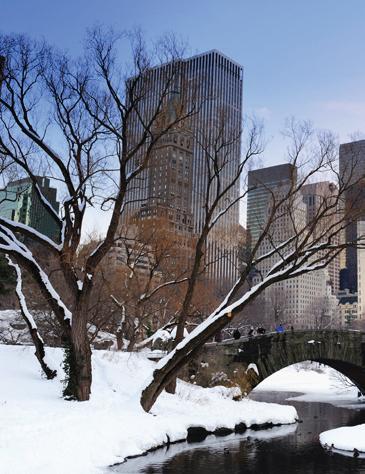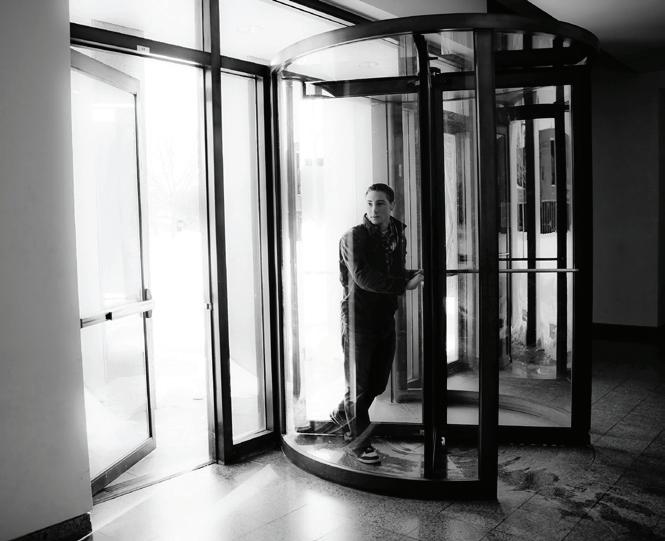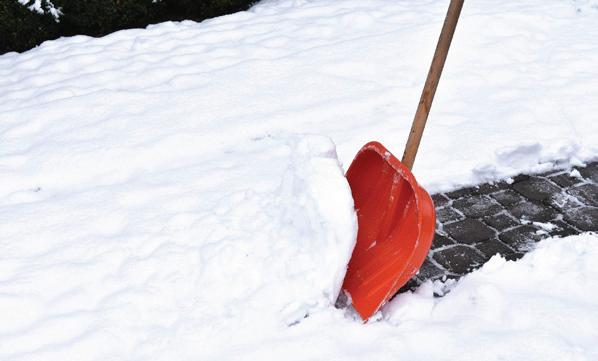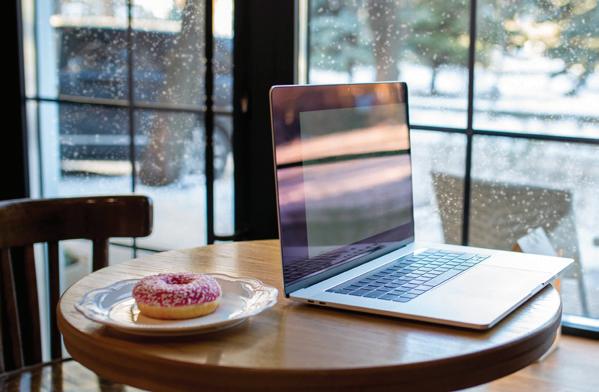
7 minute read
Edward Pim
winter wise:
top tips facilities Managers need to knoW to create safe and secure buildings
edward Pim is Senior Vice President of Operations & Experience of OpenWorks, a national leader in facilities management, providing unparalleled quality and customer service through robust technology solutions and a proven network of elite service providers. OpenWorks’ facilities maintenance services include cleaning and disinfecting, landscaping, supply replenishment, HVAC service and more. An ounce of prevention is worth a pound of cure. The old adage has never been truer, especially when it comes to preparing a building, as well as employees and visitors, for winter.

Whether in the snow belt or rainy regions, getting ready for one of the most unforgiving seasons on the calendar is vital to ensuring the preservation of facilities and safety in and around them. But often times, with limited staffing and sometimes unfamiliarity with best practices, efforts can be piecemeal at best, which can open companies up to a range of risks from accidents and injuries to costly facility repairs or even business stoppage. Depending on the property size, use and a host of other variables, the cost of properly winterizing a property is a fraction of the maintenance budget, which pales in comparison to the cost of repairing flooring, fixing burst pipes and even worstcases roof failure. In addition to thousands of dollars spent repairing various damage, there could be weeks, or even months, of non-quantifiable work interruption, inconvenience and risk.

maintenance, educated facilities managers, operations directors and property managers can prepare themselves for the worst the season can bring by following a few simple steps.
don’t leave yourself open to slip and fall liabilities
While scenic snowscapes can be dreamy, snow and ice can spell disaster, especially around building driveways, parking lots and entryways. Take an eagle-eyed approach to evaluating slip-and-fall liabilities by having a plan in place to deal with the elements to prevent incidents and injuries.
According to the Bureau of Labor Statistics (BLS), 27% of the 888,220 nonfatal work injuries resulting in days away from work in 2019 were related to slips, trips, and falls. Property owners are responsible for maintaining safe premises that are free of hazards that can cause injuries. Ways to reduce slip and fall risks include:
• Removing snow and ice from walkways and points of entry, while continually monitoring for and removing any ice or slush build-up that can occur over the course of the day. “ While scenic snowscapes can be dreamy, snow and ice can spell disaster, especially around building driveways, parking lots and entryways.”

least 4’ of non-slip mats outside and 4’ on the inside to properly dry their footwear. The mats also serve to protect flooring from ice melt, salt and puddles.
• Working with a facility management company to ensue regular monitoring of high-risk slip and fall areas to eliminate any issues before they become potential hazards.
stay on top of little issues before they become significant problems
While salt and ice melt are lifesavers in preventing slips and falls, they can quickly compromise the lifespan and safety of flooring. From carpeting and tile to hardwood and even the almost indestructible concrete-coated floors, the chemical compounds from ice melt and salt can do a number on facility floors from superficial damage to largescale degradation that requires full-scale replacement. Additionally, melting snow and ice can find ways to slip into buildings unnoticed, working their way under flooring. A solid strategy to mitigate these issues includes:
• Ensuring that cleaning and facilities management staff implement regular inspection and maintenance of flooring in high-traffic areas, especially around doors and windows. • Taking care of issues as they arise, instead of putting them on a long list of repairs that eventually need to be made.
• Maintaining weather stripping around windows and doors, and making certain that entryways are mopped regularly and non-slip mats are frequently replaced to avoid permanent damage and potentially costly repairs.
make winter facility management about people
It is easy to get caught up contracting with snow plow companies and distributing ice melt, but winter care goes beyond that to ensuring a company’s most precious commodity – its people and guests – are well protected during the winter months. A facility services partner should help companies make their worlds work better by making their facilities cleaner, safer and healthier. In addition to seasonal cold and flu, which runs rampant during the winter months, the emergence of COVID19 and the Omicron variant has heightened businesses’ determination to protect people making it more important than ever to put special focus on keeping employees, vendors and customers healthy during the season. In addition to setting out hand sanitizer in high-traffic areas and ensuring restrooms are stocked with antibacterial soap, consider incorporating some easy-to-
implement changes to support wellness in the workplace, including:
• Taking a critical look at the HVAC system and proactively making indoor air quality and properly operating ventilation a priority.
• Incorporating air cleaners that can help reduce airborne contaminants, including particles containing viruses.
Dry Hydrogen Peroxide (DHP) systems are one such system that turns humidity from the air into hydrogen peroxide that can safely and effectively reduce microbes in the air. Safe for humans, it can be used in occupied settings and provides an effective no-touch addition to a manual cleaning process, which can assist with ongoing decontamination in high-traffic areas.
• Transitioning to CDC-recommended
HEPA fan/filtration systems to enhance air cleaning, especially in high-risk areas.
• Giving employees access to basic cleaning supplies such as antibacterial wipes to help them maintain their individual spaces.
• Supplementing regular cleaning with deep cleaning, especially in common areas, that encompasses getting into nooks and crannies to keep germ breeding grounds at bay.
plan ahead to avoid supply chain headaches
From delivery delays to stock shortages, it seems every business has experienced challenges related to supply chain issues. Although winter comes every year, most organizations find themselves scrambling to keep up with weather-related issues – and this year may pose even more significant challenges to get the supplies and resources a company needs on time. Even in a milder winter climate, unexpected circumstances arise; a light dusting of snow can create snowmageddonlevel havoc in cities like Seattle, Las Vegas or Phoenix, so it becomes more important than ever to have a plan in place to prevent crippling facility issues when they arise. In fact, implementing preventative measures on a regular basis helps prevent unnecessary, unexpected and costly repair bills. This winter, get ahead by:

• Working with a facilities management firm to secure snow plow services, which will ensure priority services when snowfall occurs.
• Inspecting and repairing any HVAC to ensure top performance during the winter season.
• Stocking up on ice melt and salt before the season begins to ensure plenty is inhouse and on hand when it’s needed.
• Topping off fuel tanks and ensuring there are back-up resources available should roads close and deliveries be delayed.
• Winterizing your irrigation and any exposed pipes to protect them from the impending freeze.
surround yourself with resources to protect your facility
Facilities management has come a long way in recent years, especially as new technologies emerge to protect and preserve structures and their inhabitants. Staying on top of the latest developments, undertaking cost-benefit analyses and understanding how to right-size an approach to effective facilities management can be a full-time job in itself. Contracting with facilities management specialists to stay organized, ensure implementation of best practices suited to your unique facility and, hopefully, avoid complicated and costly problems is a critical piece of the building operations team. Highly-qualified facilities management teams can help facilities managers, operations directors, landlords and cleaning staff by:
• Providing access to the latest commercial-grade technology that enables service providers to work more efficiently and effectively, as well as the knowledge and ability to use technologies to their maximum ability.
• Reducing the burden of hiring during a labor shortage through outsourcing ensures that companies do not need to worry about turnover or finding talent, while ensuring you have well-trained service providers who follow your facility management protocols using commercial-grade tools and resources.
• Reducing high turnover rates, which in 2018 averaged an astounding 300% according to a report from 4M building solutions, with added support from firms that specialize in facilities management on your timetable. Ensuring safe and secure facilities over the winter months does not have to be a burden. By planning ahead, identifying where potential issues can arise and working closely with your facilities services and commercial cleaning provider, facilities managers can help safeguard their businesses against anything Mother Nature delivers.
want to stay on toP of the latest news and whats haPPening at the forefront of franchising?











